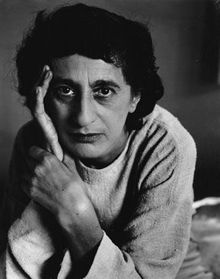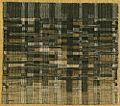Anni Albers facts for kids
Quick facts for kids
Anni Albers
|
|
|---|---|
 |
|
| Born |
Annelise Elsa Frieda Fleischmann
June 12, 1899 |
| Died | May 9, 1994 (aged 94) Orange, Connecticut, U.S.
|
| Education | Bauhaus |
| Known for | Textiles Graphic design Fine Art |
| Spouse(s) | |
Anni Albers was a German artist who lived from 1899 to 1994. Her original name was Annelise Elsa Frieda Fleischmann. She was famous for her work with textiles (like weaving) and printmaking. She helped show that crafts like weaving could be just as important as traditional art.
Besides surface qualities, such as rough and smooth, dull and shiny, hard and soft, textiles also includes colour, and, as the dominating element, texture, which is the result of the construction of weaves. Like any craft it may end in producing useful objects, or it may rise to the level of art.
Contents
Becoming an Artist: Anni Albers's Early Life
Anni Albers was born on June 12, 1899, in Berlin, Germany. Her mother's family worked in the publishing business. Her father was a furniture maker. From a young age, Anni was very interested in art.
She painted when she was young. She even studied with an Impressionist artist named Martin Brandenburg from 1916 to 1919. However, another artist, Oskar Kokoschka, once saw her portrait and asked, "Why do you paint?" This made her feel discouraged.
Anni decided to go to art school anyway. She knew it would be challenging. In 1919, she attended the Kunstgewerbeschule in Hamburg for two months. Then, in April 1922, she began studying at the Bauhaus school in Weimar.
At the Bauhaus, Anni first studied with Georg Muche and then Johannes Itten. It was hard for her to find the right workshop. Women were not allowed in some of the classes. In her second year, she wanted to join a glass workshop with her future husband, Josef Albers. But she couldn't. So, she reluctantly joined the weaving workshop.
Anni had never tried weaving before. She thought it was not a very exciting craft. But with her teacher, Gunta Stölzl, she soon learned to love the challenges of working with threads. She started creating amazing geometric designs. Anni later wrote about her time at the Bauhaus: "Threads caught me, really against my will... But circumstances held me to threads and they won me over."
Anni Albers's Creative Journey and Career
In 1925, Anni Fleischmann married Josef Albers. He quickly became a "Junior Master" at the Bauhaus. In 1926, the school moved to Dessau. The Bauhaus started focusing more on making things for everyday use. This led Anni to create many unique textiles. Her designs had special qualities like reflecting light, absorbing sound, and being durable. She even had some of her designs published. She also got contracts to create large wall hangings.
For a while, Anni Albers was a student of Paul Klee, another famous artist. After the school's director, Walter Gropius, left Dessau in 1928, the Albers family moved next door to the Klees and the Kandinskys. During this time, Anni and Josef started traveling a lot. They visited Italy, Spain, and the Canary Islands.
In 1930, Anni received her Bauhaus diploma. She was recognized for her innovative work. She used a new material called cellophane to design a wall covering that could absorb sound and reflect light.
When Gunta Stölzl left the Bauhaus in 1931, Anni Albers took over as the head of the weaving workshop. This made her one of the few women to hold such an important role at the school.
The Bauhaus in Dessau closed in 1932 because of pressure from the Nazi party. It moved briefly to Berlin but closed permanently in August 1933. Anni Albers, who was Jewish, moved with her husband to Berlin. But then they had to leave Germany. They were invited by Philip Johnson to teach at an experimental school called Black Mountain College in North Carolina. They arrived in the United States in November 1933.
At Black Mountain College, Anni Albers was an assistant professor of art. The school focused on "learning by doing." In the early 1940s, when her classroom looms weren't set up, she had her students go outside. They had to find their own weaving materials. This helped students understand materials and structures. Anni often experimented with different materials in her own work. This exercise helped students imagine what ancient weavers might have done.
Anni and Josef Albers taught at Black Mountain College until 1949. During these years, Anni's designs and weavings were shown in exhibitions across the U.S. She became a U.S. citizen in 1937.
In 1949, Anni Albers made history. She became the first textile designer to have a solo exhibition at the Museum of Modern Art (MoMA) in New York City. Her exhibition started in the fall and then traveled around the U.S. from 1951 to 1953. This made her one of the most important designers of her time. During these years, she also traveled often to Mexico and other parts of the Americas. She became a big collector of pre-Columbian artwork.
After leaving Black Mountain in 1949, Anni and Josef moved to Connecticut. Anni set up a studio in her home. She was asked by Walter Gropius to design bedspreads and other textiles for Harvard University. After her MoMA exhibition, Florence Knoll asked Anni to design textiles for the Knoll furniture company. For the next 30 years, she created fabric patterns that could be mass-produced. She also made many of her "pictorial" weavings. Some of these are still made today, more than 50 years later! She also wrote several articles and a book called On Designing. In 1961, she received the Craftsmanship Medal.
In 1963, Anni visited the Tamarind Institute in Los Angeles with her husband. She was invited to try printmaking. She immediately loved the technique. After that, she spent most of her time on lithography and screen printing. She was invited back to Tamarind in 1964. There, she created a series of six prints called Line Involvements.
Anni Albers wrote an article for the Encyclopædia Britannica in 1963. She then expanded it into her second book, On Weaving, published in 1965. This book was very important for textile design in the United States. Her design work and writings helped make Design History a serious area of study.
In 1976, Anni Albers had two big exhibitions in Germany. Over the next two decades, she had many more exhibitions. She also received several honorary doctorates and lifetime achievement awards. This included the second American Craft Council Gold Medal in 1981. In 2018, the Tate Modern Gallery in London and the Kunstsammlung Nordrhein-Westfalen in Germany held a special exhibition and published a book about her work.
Anni Albers continued to travel, design, make prints, and give lectures until she passed away on May 9, 1994, in Orange, Connecticut. Her husband, Josef Albers, had passed away in 1976.
Anni Albers's Lasting Impact
In 1971, Anni and Josef Albers started the Josef and Anni Albers Foundation. This organization helps promote art and vision through art. Today, it manages the art of both Josef and Anni Albers. It also supports exhibitions and publications about their work. The Foundation building is in Bethany, Connecticut. It has a research center, archives, and studios for visiting artists.
Anni Albers was honored for her achievements. She was inducted into the Connecticut Women's Hall of Fame in 1994.
Anni Albers's Amazing Artwork
Anni Albers was a designer who mostly worked with textiles. Later in her life, she also focused on printmaking. She used many different techniques. These included lithography, embossing, silk-screening, and photo-offset. She often made ink wash designs for her textiles. Sometimes, she even designed jewelry.
Her woven artworks include many wall hangings, curtains, and bedspreads. She also created mounted "pictorial" images and mass-produced fabric. Her weavings often combined traditional and industrial materials. She wasn't afraid to mix jute, paper, horse hair, and cellophane.
Anni's early works, like Drapery material (1923–26) and Design for Smyrna Rug (1925), show her unique style. She loved to experiment with color, shape, size, and rhythm. Her designs often featured abstract, crisscrossing geometric patterns. Her printmaking was also experimental. She would print lines multiple times, sometimes positive, sometimes negative. She would also print slightly off-register. She loved to explore what her tools could do. Anni believed that "there is no medium that cannot serve art."
Images for kids
See Also
 In Spanish: Anni Albers para niños
In Spanish: Anni Albers para niños
- Fiber art
- Gunta Stölzl
- Margaretha Reichardt
- Otti Berger
- Friedl Dicker-Brandeis
- List of German women artists







